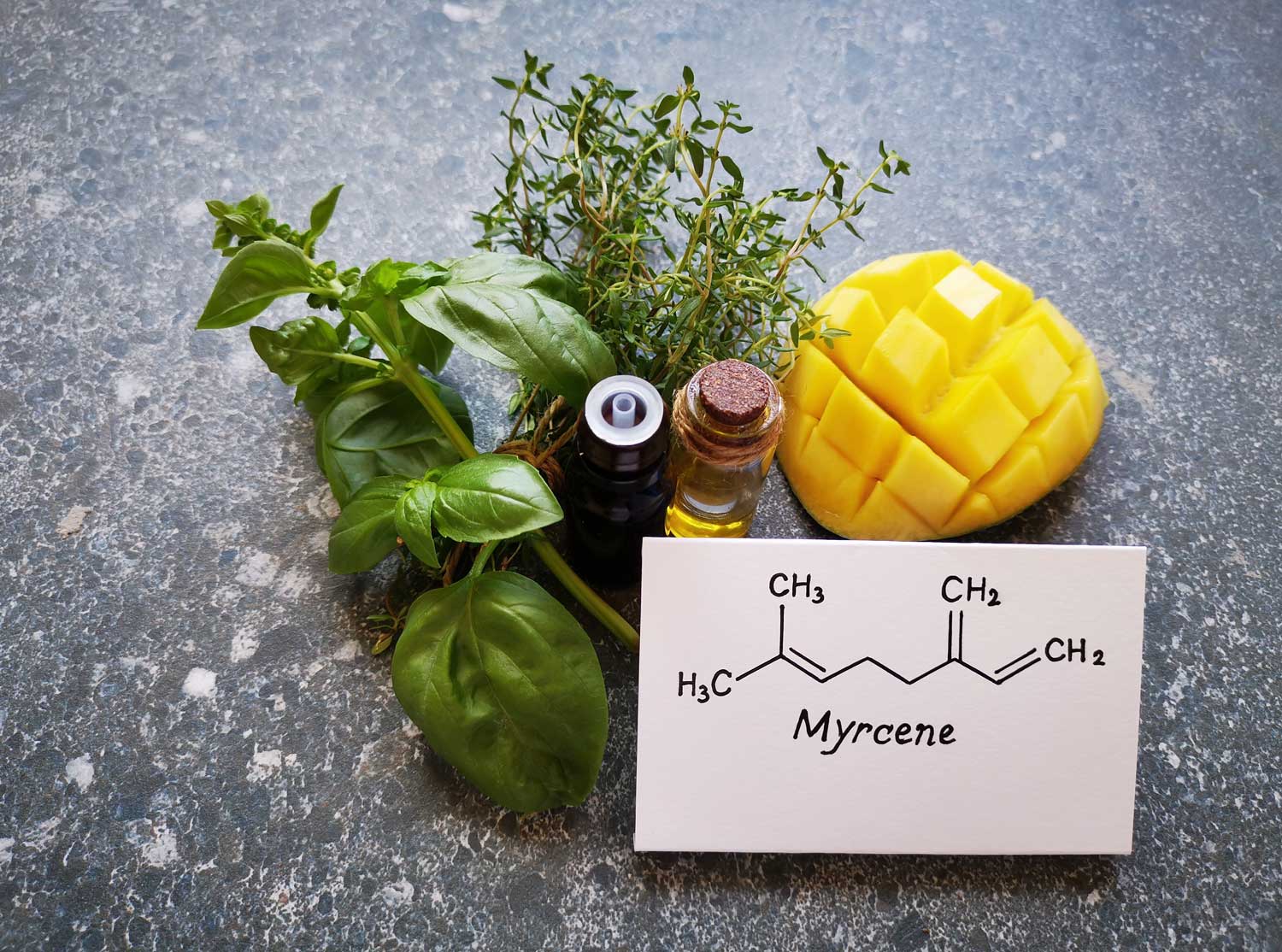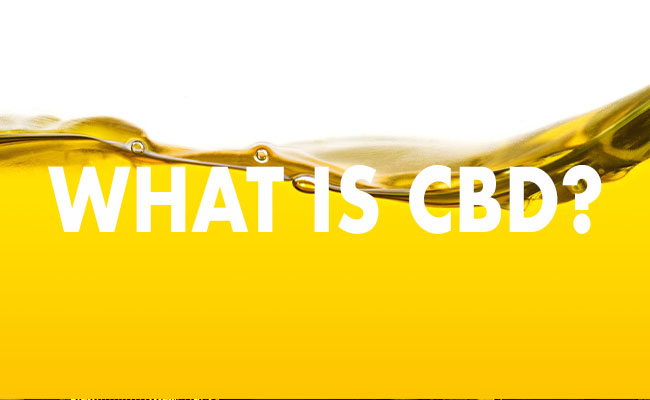
Terpenes 101 | Myrcene
WRITTEN BY TRANG TRAN AND DR. SWATHI
What is myrcene?
Terpenoids, also called terpenes, are aromatic compounds in plants that play ecological roles in protection from predation, attraction of pollinators, and many other roles. In other words, terpenoids are the essential oils that occur naturally in plants, including the cannabis plant. Specifically, the monoterpenoids (terpenoids that contain 10 carbon units) are highly bioavailable via inhalation. Myrcene (β-myrcene), which is the most prevalent monoterpene in hops and cannabis, is also found in bay leaves, eucalyptus, hops, lemongrass, mangoes, parsley, and wild thyme. It is popularly used as a food additive and flavoring and aroma agent within the food and beverage industry. Furthermore, myrcene is used in cosmetic products, soaps, and detergents.
In addition to myrcene, other terpenoids include limonene, humulene, beta-caryophyllene, alpha-pinene, and linalool.
What does myrcene smell like?
Terpenoids are responsible for the aroma of cannabis. Myrcene contributes significantly to the aromas of cannabis, giving cannabis strains a mildly sweet flavor profile as well as providing scents that are spicy, earthy, musky, fruity, and clove-like.
What is the role of myrcene in cannabis?
Cannabis strains with more than 0.5% myrcene are likely to induce sedative qualities, whereas strains with less than 0.5% myrcene may induce more upbeat and energetic feelings.
Although data is limited, myrcene may have a role in assisting the absorption of cannabinoids across the blood-brain barrier, thereby increasing transport into the brain and enhancing psychoactive responses. Specifically, by increasing the transportation of cannabinoids into the brain, myrcene contained within the cannabis plant may play a role in the pain-relieving properties of cannabinoids.
Additionally, research suggests that terpenes may regulate the affinity of THC (tetrahydrocannabinol) for CB1 receptor, which contributes to the improved pain-relieving effects of the cannabis plant. Thus, terpenoids work synergistically–through the ensemble effect–to exert certain therapeutic effects. Terpenoids are also synergistic with each other. For example, myrcene can contribute to the overall flavor of beer due to its synergistic effect with other essential oils found in hop such as linalool.
Does the content of myrcene vary depending on the phytocannabinoid content?
Yes, some studies showed that myrcene content was higher in the intermediate variety containing both THC and CBD compared to the other two varieties with high THC content and high CBD content. Overall the amount of myrcene varies strain by strain, rather than its relationship with specific cannabinoid amounts.
What are the health benefits of myrcene?
Anti-anxiety support
Research shows that myrcene may play a role in reducing anxiety. One study showed that inhalation of this cannabis essential oil (myrcene content: 22.9%) for five minutes could reduce stress and anxiety compared to control (sweet almond oil). Along with citral and limonene, myrcene has been investigated for its relaxing, sedative effects.
Of note, other terpenoids may work synergistically with myrcene to exert an anxiolytic effect. Due to limited studies in humans, the potential beneficial effect of myrcene on neurological disorders needs further research.
Anti-aging support
Exposure to UVB is associated with an overproduction of reactive oxygen species (ROS). Human studies showed that myrcene may improve skin aging through decreasing the production of ROS. As a result, myrcene may play a role in the skincare industry.
Anti-inflammatory support
Myrcene may help decrease inflammatory effects in a human chondrocyte (cartilage cell) model of osteoarthritis, thus suggesting a potential therapeutic application in the setting of progressive joint disease.
Pain-relieving support
In the body, studies show that myrcene may have a pain-relieving effect–this is posulated due to its inhibition by naloxone, an opioid blocker, suggesting a mechanism of action through the opioid receptor. Interestingly, the pain-relieving effect of myrcene actually may be mediated by the release of endogenous opioids via the alpha-2-adrenoceptor. Another potential mechanism of how myrcene supports pain management is through the activation of the transient receptor potential cation channel subfamily V member I (TRPV1) channels.
What are the safety concerns with myrcene?
According to the Food and Drug Administration (FDA), myrcene did not demonstrate genotoxic potential and was unlikely to induce tumors in humans at levels found as a food flavoring chemical. Nonetheless, the FDA no longer permits the use of myrcene as a flavoring agent under the Delaney Clause of the Federal Food, Drug, and Cosmetic Act in October 2019.
The bottom line
In summary, myrcene is a terpene that gives rise to the earthy, fruity, and clove-like aroma of cannabis. In the body, it works synergistically with THC as well as other terpenes to potentially play a role in a number of physiological processes. Topically, myrcene is considered generally safe since it has a low likelihood of causing an allergic response. Although more robust human clinical trials are needed, myrcene has shown promising health benefits.
References:
- do Vale TG, Furtado EC, Santos JG Jr, Viana GS. Central effects of citral, myrcene and limonene, constituents of essential oil chemotypes from Lippia alba (Mill.) n.e. Brown. Phytomedicine. 2002;9(8):709-714. doi:10.1078/094471102321621304
- Fischedick JT. Identification of Terpenoid Chemotypes Among High (-)-trans-Δ9- Tetrahydrocannabinol-Producing Cannabis sativa L. Cultivars. Cannabis Cannabinoid Res. 2017;2(1):34-47. Published 2017 Mar 1. doi:10.1089/can.2016.0040
- Hwang E, Ngo HTT, Park B, Seo SA, Yang JE, Yi TH. Myrcene, an Aromatic Volatile Compound, Ameliorates Human Skin Extrinsic Aging via Regulation of MMPs Production. Am J Chin Med. 2017;45(5):1113-1124. doi:10.1142/S0192415X17500604
- Jansen C, Shimoda LMN, Kawakami JK, et al. Myrcene and terpene regulation of TRPV1. Channels (Austin). 2019;13(1):344-366. doi:10.1080/19336950.2019.1654347
- Myrcene. Myrcene - an overview | ScienceDirect Topics. https://www.sciencedirect.com/topics/medicine-and-dentistry/myrcene. Accessed May 22, 2022.
- Orlando JB, Silva BO, Pires-Cunha CL, Hiruma-Lima CA, Gaivão IOM, Maistro EL. Genotoxic effects induced by beta-myrcene following metabolism by liver HepG2/C3A human cells. J Toxicol Environ Health A. 2019;82(3):176-185. doi:10.1080/15287394.2019.1577195
- Russo EB. Taming THC: potential cannabis synergy and phytocannabinoid-terpenoid entourage effects. Br J Pharmacol. 2011;163(7):1344-1364. doi:10.1111/j.1476-5381.2011.01238.x
- Russo EB, Marcu J. Cannabis Pharmacology: The Usual Suspects and a Few Promising Leads. Adv Pharmacol. 2017;80:67-134. doi:10.1016/bs.apha.2017.03.004
- Surendran S, Qassadi F, Surendran G, Lilley D, Heinrich M. Myrcene-What Are the Potential Health Benefits of This Flavouring and Aroma Agent?. Front Nutr. 2021;8:699666. Published 2021 Jul 19. doi:10.3389/fnut.2021.699666
--
This article was edited by Dr. Swathi and was written by Element Apothec Scientific Communications Intern, Trang Tran. She is a Doctor of Pharmacy (PharmD) student at Oregon State University and Oregon Health & Science University College of Pharmacy in Portland, Oregon.











